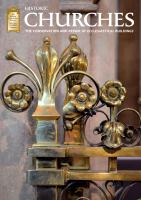

BCD SPECIAL REPORT ON
HISTORIC CHURCHES
22
ND ANNUAL EDITION
21
Solid concrete floors following a 20th-century rebuild;
note how the moisture travels up through the renewed
stonework and forms a salty crust on the original fabric.
All the detail has been overpainted in gloss oil paints.
The floor is covered in rubber backed carpeting
surrounding the repair is inconsistent,
particularly in terms of permeability,
and where it is important to provide a
smooth overall appearance
• where it is necessary to work at cold
temperatures (around 10°C) and/or
with high humidity and/or in poorly
ventilated spaces.
One other cause of poor paint adhesion
is the use of inappropriate paints to cover
traditional finishes such as limewash,
casein-based paints and whiting. Where
this is identified as a problem and the
church is ancient or from a period
when complex decorative schemes were
popular, care must be taken when offering
advice on recoating. In these cases you
are required to assume the possibility of
underlying paint schemes that might be
restored at a future date.
Wet penetration caused by a poorly
maintained surface water drainage system
or a system that does not have sufficient
capacity to control the level of water
runoff in heavy rainfall requires careful
consideration. Checks should be made
and action taken where necessary on
basic maintenance and ‘jobbing’ repairs.
Ground conditions at the base of a wall
must also be assessed. Is the area drained
(a French drain or ‘dry area’)? Are there
gullies at the base of the rainwater
downpipes? Soil and debris may have built
up. Sheds and oil tanks may have been
placed against a north wall restricting
evaporation. However, the more
fundamental difficulties often relate to the
general condition of roofs, wall head and
valley gutters.
PAINT ‘SOLUTIONS’
Selecting an appropriate paint system
is thus complicated by the need for
the coating to adhere to the substrate,
which may vary from one area to the
next, and if the substrate remains
breathable, the new paint system must
not trap moisture. Other issues which
also need to be considered include cost
(materials and labour), resistance to
staining from the substrate, resistance
to abrasion, and appearance.
One-coat paints
Specially formulated one-coat paints such
as Classidur Tradition are designed to
adhere to a variety of backgrounds and
substrates without sealants or undercoats,
and have a flat matt finish. These paints
have good vapour permeability, resist salt
formation and retain elasticity over time.
To avoid black spot mildew, one-coat
paints should not be of the ‘plant-based
oil’ (soya) variety. Cover depends on
substrate – further coats may be required
to provide even cover.
POSITIVES
The paint is designed to adhere well to
all kinds of substrate, including moist
backgrounds. It is non-yellowing with
excellent stain-covering properties,
hardens rapidly and has very good
mechanical resistance. As it does not
penetrate into the underlying paints, it
may be used where there is evidence of
underlying limewash and other traditional
paints. Due to its chemical properties
it might be removed as a single layer at
some future date.
NEGATIVES
The paint is relatively expensive. It can be
difficult to apply in some circumstances.
It is only available in white.
Basic (low cost) contract matt emulsions
Emulsion paints are water-based paints
in which the paint material is dispersed
in a liquid that consists mainly of water.
Where suitable these have the advantage
of being fast-drying with low toxicity, low
cost, easy application, and easy cleaning
of equipment, among other factors. On
the basis that low cost means minimal use
of expensive oil-based compounds such as
vinyl, a basic trade product will have high
mineral (packer) content such as chalk.
As a result, the paint will be permeable
to water vapour. (If you are uncertain
whether the paint has a high mineral
content, try using it outside to see how
rapidly it degrades.)
Use where the church does not have
problems with damp or paint adherence,
and where there are already many
overlying coats of emulsion. (Although
Modern, impermeable paint peeling due to damp
replaced, it is best to use fibre-reinforced
natural lime plasters. However, in some
circumstances an alternative proprietary
lime-rich renovating plaster mix may be
used. Limelite for example contains both
lime and fibrous reinforcement, albeit
with a small amount of cement. When
set, these plasters have a light and open
structure that allows water vapour to
pass through. There are mixes suitable
for upper and lower wall conditions, and
the skim coat adheres particularly well to
all types of surface, even those which are
impermeable. The manufacturers offer
good technical guidance and support.
Proprietary lime-rich renovating
plasters such as Limelite are best used in
the following circumstances:
• where working at high level – wall and
ceiling-renovating plasters are lighter
weight and will penetrate crevices and
timber lath more readily
• where the underlying masonry is
particularly hard, impermeable and
smooth
• as a skim coat where the surface
















